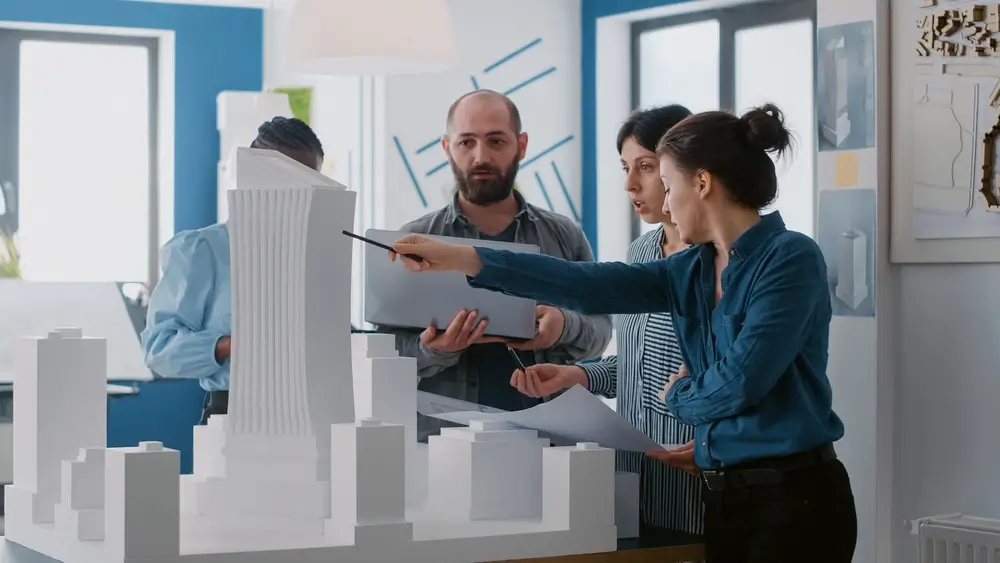A company’s ability to succeed in the current competitive market is greatly influenced by the layout and style of its office premises. Professionals in the field of commercial architecture are experts in designing spaces that support worker well-being, efficiency, and brand identification, in addition to fulfilling operational requirements. This article examines the ways in which commercial architects improve office spaces, emphasizing the seven main methods in which they help to create the best possible work environments.
Understanding Business Needs and Objectives
To begin improving a corporate space, commercial architects must first ascertain the specific requirements and goals of the enterprise. This entails in-depth discussions on the company’s mission, values, and objectives with stakeholders. Architects are able to customize their designs to fit these goals by having a thorough grasp of the company. The design process starts with a thorough grasp of the goals the organization has for itself, whether those goals are to improve efficiency, encourage teamwork, or provide an unforgettable client experience.
Optimizing Space Utilization
In a commercial setting, space use efficiency is essential. Optimizing space usage to make the most use of every square foot is the specialty of commercial architects. This involves creating layouts that support effective processes, cut down on unused space, and allow for expansion in the future. This might entail arranging a combination of breakout rooms, private offices, and collaborative workplaces in an office setting. It could entail streamlining client flow and product displays in retail settings. Architects improve the effectiveness and efficiency of corporate operations by making the most use of available space.
Enhancing Employee Well-Being and Productivity
Productivity and work satisfaction are directly correlated with employee well-being. Business spaces are improved by commercial architects who include design components that encourage a productive and healthy work environment. This might involve taking advantage of natural light, comfortable furnishings, and areas designated for leisure and enjoyment. Additionally, architects create environments that accommodate different work patterns, such as open areas for collaboration and quiet places for concentrated concentration. Architects assist companies in lowering employee attrition, attracting top talent, and enhancing overall performance by putting employee well-being first.
Integrating Advanced Technology
Technology integration is crucial for corporate success in the current digital era. Business spaces are improved by commercial architects Colorado that skillfully integrate cutting-edge technology into their renderings. This covers everything from interactive displays and video conference facilities to high-speed internet and smart building technologies. Architects enhance operational efficiency and facilitate contemporary work habits by incorporating technology into their designs. Businesses may gain a competitive advantage by using technology-enhanced venues, which provide improved customer interactions, data management, and communication.

Implementing Sustainable Design Practices
Sustainability is becoming a more crucial factor in company design. By using sustainable design principles that lessen their negative effects on the environment and encourage long-term cost savings, commercial architects improve commercial environments. This can involve using sustainable building materials, HVAC systems, and energy-efficient lighting. Architects also reduce waste and conserve water in their designs. In addition to helping the environment, sustainable design improves a company’s reputation and, over time, can result in considerable operating cost savings.
Creating Flexible and Adaptable Spaces
Because the corporate environment is dynamic, venues must change to meet evolving demands. Commercial architects design flexible and adaptive facilities that may change with the business. This might entail designing modular floor plans, moveable walls, and multipurpose spaces that are adaptable to changing needs. Changes in team numbers, market needs, and corporate processes may all be readily accommodated in flexible spaces. Architects that build with flexibility make sure that workspaces are practical and relevant for a long time, adding value to the organization.
Conclusion
Creating settings that serve corporate objectives, represent brand identity, improve space use, encourage employee well-being, integrate technology, apply sustainable practices, and offer flexibility are all important tasks performed by commercial architects. Businesses may design places that not only fit their present requirements but also position them for future success by using their expertise. Making the strategic choice to hire a professional architect may have a big influence on a business’s productivity, happiness among its staff, and overall expansion. Commercial architects will always be essential in creating creative yet practical environments as the corporate environment changes.






